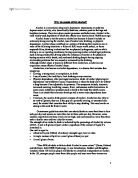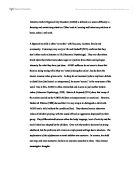Using Sources A and B, and your own knowledge, describe two significant changes in medicine in the period 1450 - 1700.
Medicine Coursework Study Sources A and B and use your own knowledge. Using Sources A and B, and your own knowledge, describe two significant changes in medicine in the period 1450 - 1700. a) Whilst women weren't trained in medicine during this time period, their traditional roles as healers and midwives were still important ones but women only ever performed them. These roles were just extensions of their status as housewives which can be seen by the way they performed such tasks. Women would use their knowledge of herbs to concoct remedies for the sick and they would record them in recipe books to be handed down to their children. They would also hand down certain recipes by word of mouth. Source A supports this in that it shows a lay Sister preparing a remedy in just such a way. With the arrival of a more medicine-aware society, the role of healer shifted into the hands of merchants and businessman. New drugs coming in from foreign lands, such as the New World, were handled by these very people and were not available to women. Source B shows that when it says: New and expensive cures were developed using the drugs imported as a result of trade between Europe and India, China and the New World. These drugs were handled by merchants and businessmen, surgeons and chemists. They were not easily available for women to use. They were obtained by men, handled by men, and sold
Why do people drink alcohol
Why do people drink alcohol? Alcohol is a recreational drug and a depressant. Depressants or sedatives depress neural activity, slow down bodily functions, enhance positive feelings and heighten alertness. They slow down mental processes and behaviours. Alcohol is the most widely used depressant of which the effects were known about 10,000 years ago. Alcohol abuse is not the same as alcoholism because it doesn't include an extremely strong craving for alcohol, loss of control over drinking, or physical dependence. Alcohol abuse is defined as a pattern of drinking that results in one or more of the following situations: a failure to fulfil major work, school, or home responsibilities; drinking in situations that are physically dangerous, such as while driving a car or operating machinery; having recurring alcohol-related legal problems, such as being arrested for driving under the influence of alcohol or for physically hurting someone while drunk; and continued drinking despite having ongoing relationship problems that are caused or worsened by the drinking. Although alcohol abuse is basically different from alcoholism, alcoholics also experience many effects of alcohol abuse. Alcoholism, also known as alcohol dependence, is a disease that includes four symptoms: * Craving, a strong need, or compulsion, to drink. * Loss of control, the inability to limit drinking on any
Does alternative medicine present a challenge to biomedicine?
Does alternative medicine present a challenge to biomedicine? Alternative medicine such as herbal remedies, Reiki, hypnosis, aromatherapy, and acupuncture are all ancient methods of medicine that have been used to heal patients for centuries. These holistic approaches to medicine are becoming increasingly popular as ways to improve the health and well being of individuals in contemporary societies, now commonly described as complementary medicine. This essay will discuss why people seek alternative or complementary medicine in favour of the conventional biomedical methods. I will then consider whether these holistic treatments challenge scientific medicine, or whether the two approaches can work along side each other. To begin with, I will describe what complementary and alternative medicine is. Complementary medicine is a group of therapeutic and diagnostic disciplines that focus on the individual as whole which contrasts with the biomedical model that views the body and mind as separate from each other. It exists outside the realms of biomedicine and the institutions that teach and provide healthcare based on the scientific approach. Complementary and alternative medicine has been set into groups but it is hard to define where each should go. A report by the House of Lords Select Committee for Science and Technology (2000), divides each therapy into groups ranging from
Ancient Egyptian and Greek Medicine, a Comparison.
Ancient Egyptian and Greek medicine, a comparison. Introduction In this essay, we shall be comparing the progress of medicine in ancient Egypt and ancient Greece. We will explore the different factors contributing to the medical development of each civilisation and how they formed the basis for modern medical practice. Economy Egypt and Greece were agricultural empires. Egypt was one of the first to settle and farm the Nile. Good harvests from the rich silt meant that Egypt had enough food to trade with other Empires, like India, China, Arabia, Africa and around the Mediterranean. Trade (along with bringing back great wealth) brought back new ideas, among which were new herbs and treatments. Similarly, Greece was a trading nation, leading to communication in and between nations. Communication was vital for the progress of medicine because it allowed ideas to be shared between many different countries. The Egyptians were so successful with farming and trade that the land owners became very wealthy. Likewise, the Greeks had a wealthy upper class. This new class could afford to pay for health care by doctors, who were paid a great deal for their knowledge. They spent their lives trying to further their understanding of medicine, probably because the better they were, the more they got paid. So money plays a large part in the progress of medicine. The rich could afford to
Will Hong Kong maintain its position of being the leader of the Traditional Chinese Medicine Market after China Accession to World Trade Organisation?
Will Hong Kong maintain its position of being the leader of the Traditional Chinese Medicine Market after China Accession to World Trade Organisation? - An analysis of Hong Kong's Traditional Chinese Medicine market and it's future _______________________________________________ INTRODUCTION As a colony of UK, Hong Kong joined WTO on 1st January of 1995. Despite its small physical size and a population of only 7 million, Hong Kong currently ranks as the 10th largest trading entity in the world, with trade valued at some US$400 billion per year. It is the strategic trade services platform connecting the USA, Western Europe and mainland of China. This highly energised platform is infused with ideas, talent and connectivity. It leverages a critical mass of business networks in the Chinese mainland and overseas. As a gate to the "mysterious" orient, Hong Kong had been a major port and trade centre for the exotic Far Eastern produces such as Traditional Chinese Medicine (TCM). The tiny TCM industry1 was well established prior to Hong Kong's assertion to WTO in 1995. The trades took the form of retail, wholesale or transit. The trade volume had been relatively small, yet it has enjoyed quite steadily growth for decades. In October 1997, Hong Kong reunited as a part of China, while keeping its democratic political system and capitalistic market economy. In December
the effect of a coloured letter in a word or non word on the reaction time of recognition processes.
Abstract This study examined the effect of a coloured letter in a word or non word on the reaction time of recognition processes. . Six hundred and twenty six participants (292 M, 334 F, M = 27.97 years, SD = 12.07 years) were asked to read a set of lists and name the ink colours which the words were printed in. In this case, two level of stimuli were used; namely the word or non-word. They were then timed on their reaction time when processing the colour of the letter positioned in a word and in a non word. The hypothesis stated that the position of the coloured letter interferes with the reaction time in the word recognition process. Not only this, the position of the colored word will also affect the reaction time. Finally, it was concluded that the position of the coloured letter does affect the colour naming task. Introduction Humans have many behaviours that are automatic like sensory reactions. Learned behaviours like reading are also said to be automatic where a stimuli elicits the behaviour in the absence of intention. The analyses of single words of semantic and lexical are uncontrollable. The "Stroop effect" occurred when the identification of the colour of an incongruent word is much slower than the identification of a congruent word (Besner, Stolz, & Jones, 1997). J.R Stroop was the man who introduced the "Stroop task" in 1935. He published an article on
Attention Deficit Hyperactivity Disorder (ADHD) is defined as a severe difficulty in focusing and maintaining attention. Often leads to learning and behaviour problems at home, school, and work.
Attention Deficit Hyperactivity Disorder (ADHD) is defined as a severe difficulty in focusing and maintaining attention. Often leads to learning and behaviour problems at home, school, and work. A hyperactive child is often 'in trouble' with his peers, teachers, family and community. It develops very early in life and Denhoff (1973) confirms that they don't often reach milestones in life (Abnormal Psychology). They are often taken aback when their behaviours educe anger or rejection from others and apologise intensely for what they have just done. ADHD sufferers do not seem to know that they are doing wrong while they are 'actually doing the action', but do show the sincere remorse when given out to. As they do not necessarily show any basic deficits or disabilities (intellectual or interpersonal) he seems 'normal' in the very sense of the word. Due to this, ADHD is often overlooked and is seen as just another trouble-maker (Abnormal Psychology, 1978). Schain & Reynard (1975) show that many of the actions carried out by ADHD children as temperamental or emotional. However, Henker & Whalen (1989) showed that it is very simple to distinguish a child with ADHD and a child without the condition (Bee). They showed novice observers videos of children playing, with the sound off and no aggression displayed by either group. They differentiated between either the body
Today I would like to talk to you about alternative medicine, and why we should not ignore it entirely.
ALTERNATIVE MEDICINE - DO NOT NEGLECT ITS POWER Today I would like to talk to you about alternative medicine, and why we should not ignore it entirely. Chemotherapy, organ transplants, heart surgeries are some of the modern day miracles, which make possible for people to live longer, healthier lives. And so are treatments like Reiki, acupuncture, hypnosis, aromatherapy and herbal remedies - all ancient methods of medicine that have been used to heal patients for centuries. STATISTICS Two major surveys have indicated that use of alternative treatments is increasing in the United States. One survey in 1990 found that 33.8% of Americans were using some form of alternative medicine and a later survey by the same individual, Dr. David Eisenberg, found that use had increased to 42.1% in 1997. That means at least one in two or three people seek alternative treatment for their illnesses. REASONS So what makes them all seek this alternative assistance with increasing confidence? The Michigan Center in the USA wanted to find out why people turn to alternative methods, especially if they have some of the best of modern medicine available to them. One of the doctors involved in the research said that: "What we've found from our one-on-one interviews and surveys is that people, for example who had a heart attack, begin to re-evaluate their life when their health changes. And
Discuss the Nature of Some Major Psychotherapies and Critically Evaluate Their Effectiveness.
DISCUSS THE NATURE OF SOME MAJOR PSYCHOTHERAPIES AND CRITICALLY EVALUATE THEIR EFFECTIVENESS. Psychotherapies, in general, are developed in direct relation to and, often, as a result of specific personality theories, so, when looking at the nature of any particular therapy it is appropriate to do so in conjunction with the personality theory from which that psychotherapy was developed. Psychoanalysis and Psychodynamic therapies were developed as a result of Sigmund Freud's (1856 - 1939) theory of personality development, which he formulated, during the 1880's, after working with Charcot in Paris. He began to speculate about the nature of the illnesses suffered by some patients which appeared to him not to have a biological source, this led to his theories of the unconscious. His analysis of himself drew him to the conclusion that many of the problems suffered by patients with 'neurotic' or 'hysteria' based mental disorders could be helped with this type of analysis and psychoanalysis was 'born'. Behaviour therapy, in contrast, was developed less from a personality theory and more from the ideas of learning theorists and the theories of behaviourist psychologist's, such as Watson (1878 - 1958) and Skinner (1904 - 1990). Watson, an animal psychologist, advocated experimental psychology which concentrated on behaviour rather than motivations and this led to a revolution in how
What is known about how people perceive, take and communicate risks?
What is known about how people perceive, take and communicate risks? Human judgment dictates that physical consequences of hazards are objective, however perceptions of risks associated with those hazards are highly subjective and as a result risk has been defined in a number of ways. Risk can be viewed as the probability and/or seriousness of undesired consequences or the variance of all consequences about their mean. Research into this topic has been tackled descriptively by psychologists and has looked at why people take risks, the factors that affect their perception or appraisal, their propensity to take risks and the best techniques for risk communication. Slovic (1987) identified three risk appraisal factors, basic dimensions connected with the perception of risk. The first is "Dread Risk" characterised by a perceived lack of control, catastrophic potential, fatal consequences and the unbalanced distribution of risks and benefits. This dimension is closely related to the general public's perception of risks for example associated with nuclear power stations. The second risk appraisal factor is "Unknown risks". These are hazards for which the risks are as yet unknown and delayed in their expression of harm. For example, the risks associated with mobile phones. The final risk appraisal factor relates to how widespread the effects are of a risk where the greater the











